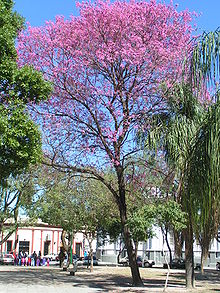Tabebuia impetiginosa
| Handroanthus impetiginosus | |
|---|---|
 |
|
| Handroanthus impetiginosus flowering in Corrientes, Argentina. | |
|
Not evaluated (IUCN 3.1)
|
|
| Scientific classification | |
| Kingdom: | Plantae |
| (unranked): | Angiosperms |
| (unranked): | Eudicots |
| (unranked): | Asterids |
| Order: | Lamiales |
| Family: | Bignoniaceae |
| Tribe: | Tecomeae |
| Genus: | Handroanthus |
| Species: | H. impetiginosus |
| Binomial name | |
|
Handroanthus impetiginosus (Mart. ex DC.) Mattos |
|
| Synonyms | |
|
|
Handroanthus impetiginosus,pink ipê, pink lapacho, or pink trumpet tree is a native Bignoniaceae tree of America, distributed from northern Mexico south to northern Argentina. Lapacho is the national tree of Paraguay, and it is also a common tree in Argentina's northeastern region, as well as in southeastern Bolivia. According to Native Trees of Trinidad and Tobago, this tree is not indigenous to Trinidad, it is introduced.
It is a conspicuous and well-known species with a long history of human use. Consequently, it has a range of local names: ipê-cavatã, ipê-comum, ipê-reto, ipê-rosa, ipê-roxo-damata, lapacho negro, pau d'arco-roxo, peúva or piúva. The timber is sometimes traded as "Brazilwood", which properly refers to the unrelated Pernambuco tree (Caesalpinia echinata).
The pink lapacho is a rather large deciduous tree, with trunks sometimes reaching 8 dm width and 30 m height. Usually a third of that height is trunk, and two thirds are its longer branches. It has a large, globous, but often sparse canopy. The tree has a slow growth rate. Leaves are opposite and petiolate, 2 to 3 inches long, elliptic and lanceolate, with lightly serrated margins and pinnate venation. The leaves are palmately compound with usually 5 leaflets.
Its bark is brownish grey, tough and hard to peel. The wood is of a pleasant yellowish colour, barely knotted and very tough and heavy (0,935 kg/dm³). It's rich in tannins and therefore very resistant to weather and sun. It is not very useful for furniture since it is so hard to work by hand. It can be found as beams or fulfilling other structural uses where needed outdoors.
In the southern hemisphere, pink lapacho flowers between July and September, before the new leaves appear. In the northern hemisphere like India, the flowering season is December to January, after the leaves are shed. The flower is large, tubular shaped, its corolla is often pink or magenta, though exceptionally seen white, about 2 inches long. There are four stamens and a staminode. The fruit consists of a narrow dehiscent capsule containing several winged seeds.
...
Wikipedia
